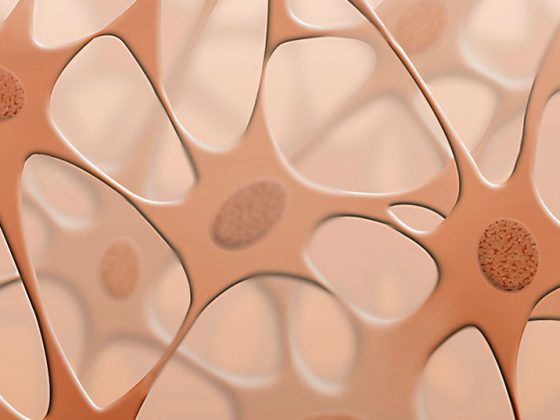Infantile hemangiomas are the most common benign tumors in children. They are either congenital or develop within the first weeks of life. Therapy is indicated for complicated manifestations and impending functional complications, ulceration, or impending permanent cosmetic damage.
According to the SK2 guideline, infantile hemangioma is defined as a proliferating vascular tumor similar to placental tissue in their antigenic structure, for which local or regional tissue hypoxia is discussed as a possible pathogenetic factor [1]. They are found in 1.1-2.6% of all mature newborns; in the first year of life, the prevalence is 10-12% [2]. There are precursor lesions such as circumscribed telangiectasias, anemic, reddish or bluish macules, or nevus flammeus-like changes. However, a classic infantile hemangioma never already appears as a tumor at birth [1]. The risk of developing hemangioma increases with decrease in birth weight. For every 500 g less birth weight, the risk increases by 40% [3]. For unknown reasons, girls are three to five times more likely to be affected than boys.
The hemangioma does not always regress completely
Infantile hemangioma progresses through three stages:
- a growth
- a standstill and
- a regression phase.
In the growth phase, which is usually over 6-9 months, it proliferates at different rates with area spread and especially with exophytic or endophytic-subcutaneous growth, often in combinations. After that, a plateau phase is reached, which can last from weeks to months. The regression phase varies in speed depending on size and location and is usually completed around the age of 9 [1].
Small cutaneous hemangiomas usually leave nothing behind. Larger hemangiomas are often associated with telangiectasias, areas of atrophic skin, scars, cutis laxa, hyper- or hypopigmentation, or a dewlap-like fibro-lipomatous tissue proliferation [1]. In them, about 10% of the hemangioma volume regresses per year from the second year of life, leaving about 50% of the tumor volume at five years of age and about 10% at nine years of age.
Differential diagnosis supports therapy consideration
The diagnosis can usually be made anamnestically and clinically. It requires clarification of two main issues:
- Is there an infantile hemangioma, other vascular tumor, or vascular malformation?
- If infantile hemangioma is present: What stage is it in?
Infantile hemangiomas must be differentiated from other vascular tumors, e.g., kaposiform hemangioendothelioma (KHE) or granulomapyogenicum, on the one hand, and from arterial, venous, lymphatic, or combined malformations of the vascular system, on the other [1]. If the diagnosis is unclear, ultrasonography with duplex sonography and biopsy for GLUT1 determination may be useful.
Whether an active therapeutic approach is indicated can only be decided on an individual basis. In uncomplicated infantile hemangiomas in unproblematic localization and without functional impairment, no therapy is required. Drug treatment, on the other hand, should be initiated urgently in the case of:
- life-threatening or threatening functional complication with appropriate localization and extension (e.g., periorificial or laryngeal hemangiomas).
- impending or already manifested ulceration, predominantly because of the painfulness.
- threat of permanent cosmetic impairment even after the hemangioma has healed, e.g. large hemangiomas in the facial region.
Avoid consequential damage
First-line therapy is usually systemic therapy with propranolol. The mechanism of action is explained by the influence on endothelial cells, vascular tone, angiogenesis and apoptosis [4]. Large meta-analyses and randomized controlled trials have demonstrated a 98% response rate [1]. Propranolol is administered at a dose of 2-3 mg/kg body weight. Ideally, the start of therapy is between the fourth and tenth week of life, as the most rapid hemangioma growth occurs during this time. Irreversible damage such as skin atrophy, scarring and excess connective tissue can be avoided as best as possible. Therapy should be continued until the patient reaches one year of age to minimize the risk of recurrence after cessation of therapy.
The first dose is administered under monitoring of blood pressure and heart rate in an outpatient or inpatient setting. The active substance is usually well tolerated. Possible adverse effects usually disappear in the course of therapy. Contraindications to systemic therapy with propranolol include bradycardia, hypotension, AV block >2nd degree, heart failure, pulmonary obstruction, hypoglycemic tendency, and pheochromocytoma.
Literature:
- %C3%(last call 02/16/20)
- Bruckner AL, Frieden IJ: Hemangiomas of infancy. J Am Acad Dermatol 2003; 48(4): 477-493.
- Drolet BA, et al: Infantile hemangiomas: an emerging health issue linked to an increased rate of low birth weight infants. J Pediatr 2008; 153(5): 712-715.
- Rotter A, de Oliveira ZNP: Infantile hemangioma: pathogenesis and mechanisms of action of propranolol. J Dtsch Dermatol Ges 2017; 15(12): 1185-1190.
InFo ONCOLOGY & HEMATOLOGY 2020; 8(1): 25.
DERMATOLOGY PRACTICE 2020; 30(1): 28











